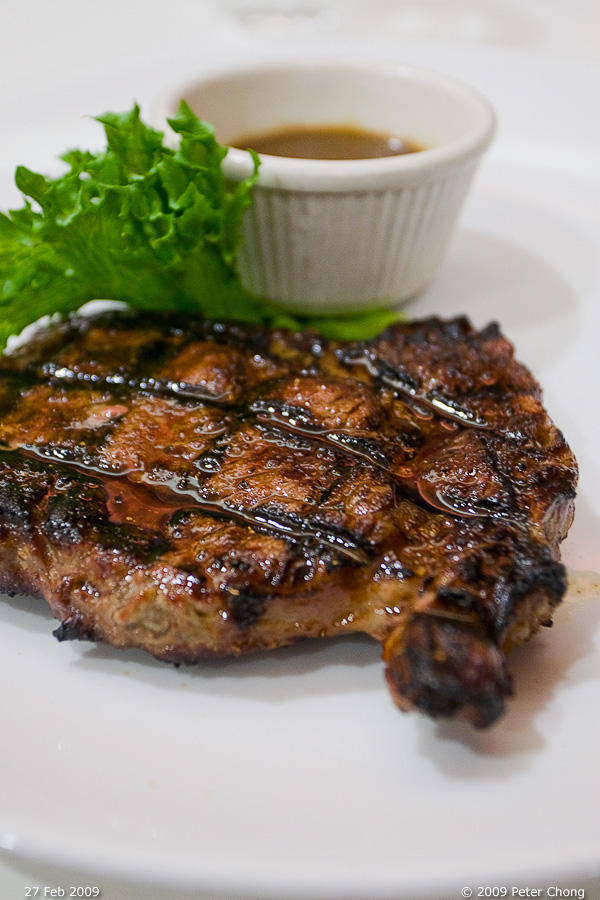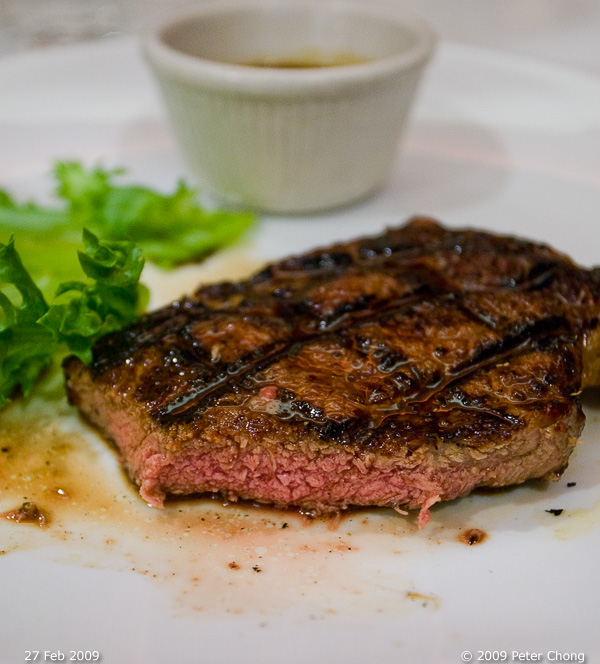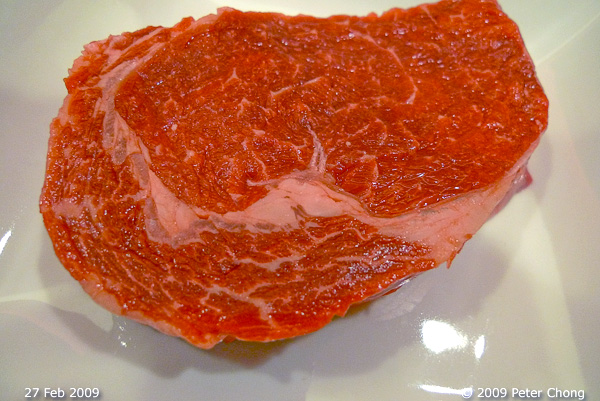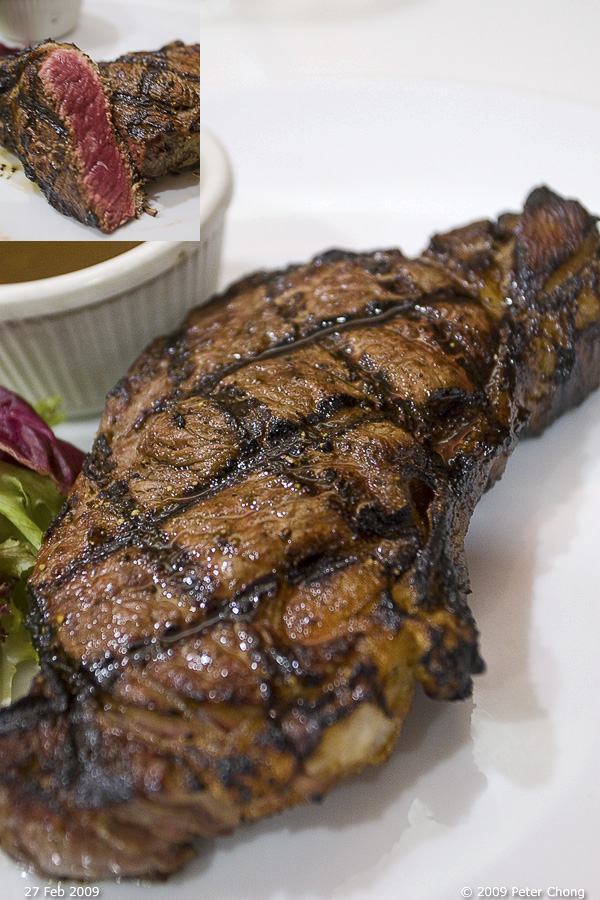When ieat organized a makan session to taste steaks at Astons...I was immediately intrigued and signed up. Brought the whole family there...including my sister who was visiting from Penang and my mom...who normally is not keen on western food.
So off to Aston's Prime at Joo Chiat we went. Aston's is famous (infamous?) for great steaks, value for money and long, long queues outside their stores islandwide. So is this value for money chain going to be able to increase the level of steaks in Singapore? You bet! So read on.
The whole ieat gang took up the entire restaurant, and the occassion was to test out the new sizzling hot plates that Aston just bought, and to for the team to provide critical feedback to Aston. Aston was generous enough to donate the entire takings for the evening to charity. Well done Aston.
I had the opportunity to sample quite a few steaks. Of those which stood out were the following:

My cut of porterhouse was quite nicely done. I had requested for Chicago medium - a style where the outside is charred crisp, and the inside remains warm and medium. I guess Aston didn't understand what I wanted, and delivered a perfectly nice medium porterhouse.
My preferred cut for a steak is a slab of Porterhouse, well marbled, dry aged and done Chicago Medium. As I have blogged before, Peter Lugers serves the best I have tasted, and Mamou's in Manila is a close second. My thoughts on a good steak have been documented here.
Dry aging of beef is a critical step to good steaks. Aging generates flavour. The enzymes within the meat attacks molecules indescriminately, turning flavourless large molecules to smaller, flavourfull fragments. They turn protein into amino acids which are savoury to the palate and glycogen into glucose. Glucose provides the sweetness you can detect in aged beef, and provides the sugar for the important Maillard reaction.
Enzymes called calpains weaken the supporting proteins that hold the contracting filaments of muscle together. Others like cathepsins also weaken the collagen in connective tissue. This causes more collagen to dissolve into gelatin during cooking making the meat more tender and succulent. The weakened connective tissue squeezes the meat less which means it loses less moisture during cooking.
To qualify to be a porterhouse, the meat must be at least 1.5"thick. Aston's porterhouse was a little on the thin side...about an inch thick, perhaps a little less, and closer to a T-bone steak than a porterhouse, although the T-bone is usually taken further posterior of the carcass than porterhouse.
The porterhouse is the preferred cut for steak lovers and those in the know because it actually comprises of two cuts of meat. The tenderloin is the larger part of the porterhouse, separated from the toploin by the bone. The tenderloin is the most tender cut, but may not be most flavourful.
The toploin is also known as sirloin, and is more flavourful, but tougher than tenderloin. (supposedly, an English king was served toploin and he was so pleased with the meat, that he drew his sword and knighted the meat...henceforth known as Sir Loin)...toploin is also known as New York Strip.
The porterhouse, being with bone, the meat is usually more tasty. Indeed this is the standard steak served by the legendary steakhouse Peter Lugers.
My cut from Aston, as I mentioned was done standard medium. The meat was as it should be, tender where it should, and flavourfull where it should. But I wished for a bit more tenderness on both cuts - a tenderness and nuttiness which can only result from 14 to 21 days of dry aging. And for the meat to be a bit more marbled. The porterhouses served that evening was also a bit variable, pointing perhaps to the fact that Aston could tighten quality control of the cooking...as though mine was standard medium, others had theirs too well done resulting in a dry steak.
I ended up in a discussion with Aston, and challenged him to come up with the goods, so to speak...make a Chicago Medium steak. He was as passionate about steaks as I was...or perhaps more...afterall he owns a chain of steak houses...wish I too owned a chain of steakhouses...anyway, he was game, and tried with the NZ Black Angus ribeye.

The outside was seared nice and charred black by his griddle. As it sat, it glistens and beckons. This was a winner. The Maillard reactants, Dr. ieat explained that indeed the reducing sugars are found within the muscles, so the browning of the meat is Maillard Reaction, and charring made a wonderful smokey char flavour. But cut into the steak, and it was beautifully medium inside.

The cut steak above shows Chicago Medium as it should be done. And as can be seen with the rough sinews of muscle, the steak was a bit lacking in marbling.
On tasting, it affirms my wish for dry aging of the beef. During the dry aging process, the natural enzymes within the beef can do some pre-digestion of the sinews during the aging, producing characteristic tender and nutty flavour only present in dry aged beef. And as with the porterhouse, I also wished for a more marbled cut...not wagyu grade 9 level of marbelling. Just USDA Prime.
Here is how the meat looked before cooking. Note the vein of fat in the middle characteristic of a ribeye:

Aston also cooked up a NZ Black Angus strip loin, done up Pittsburg style, which is also known as black and blue or Chicago rare.

Note the rare interior shown in the insert, but charred crisp exterior. The steak remained quite tender, but the same wish for dry aging remains.
In all, the steaks served at Aston's were excellent, and the only thing that kept them from being great in my books has been repeated throughout this article, but stands repeating:
1. start with USDA prime beef, with requisite marbling
2. dry age the beef from 14 to 21 days
Read also ieat's report found here.
ASTONS PRIME
467 Joo Chiat Road
Tel: 6344 2447
1130-2200hrs (Opens Daily)
4 comments:
Hi Peter,
Wholeheartedly agree with you on the merits and benefits of a properly dry-aged piece of meat. The flavors are intensified greatly and the resulting steak, if properly cooked, produces a true euphoria for meat-lovers.
Coming from NYC, I agree on the best steaks coming from Peter Luger's. Recently discovered your blog and was wondering if you have a recommendation for a top quality, dry-aged, USDA Prime steak cooked to Chicago medium in Singapore?
Cheers,
Duncan
Hi Duncan, none that I know of yet. Aston is bringing in some dry aged beef from either Australia or US. I will go try when they do.
Currently The Big D's Grill brings in air dried Blackmoore full board wagyu, but I don't know if Damien will be able to do Chicago medium. I tried the intercostal cut, cooked a bit on the rare. The meat was very good, but for me no cigars. See two entries earlier. Will see if I can persuade him to cook the way I like it.
Stay tuned.
Cheers.
Thanks Peter.
Already have plans to go to Big D's this week. A really great steak is one of the few things that I really miss from BYC.
Enjoying your blog and looking forward to more good makan tips.
Cheers.
hi pchong,
have you tried the new relocated aston's prime? i'm not sure if it'd be as good as its previous location at katong.
Post a Comment